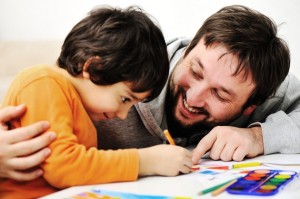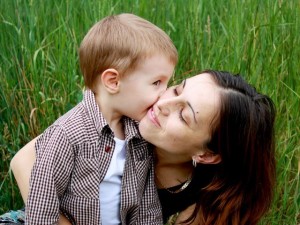 In general, mums get to spend alot of time with their children. This is mostly to do with the fact that, in the early days, infants are highly dependent on their mother especially if she is exclusively breastfeeding, and the pattern tends to continue as children get older. Dads, on the other hand, often aren’t afforded as much time with the children.
In general, mums get to spend alot of time with their children. This is mostly to do with the fact that, in the early days, infants are highly dependent on their mother especially if she is exclusively breastfeeding, and the pattern tends to continue as children get older. Dads, on the other hand, often aren’t afforded as much time with the children.
Children benefit from quality input from both parents and as such, it is really important that dads get to have some quality time with their kids as well as mums. Studies show that some dads spend as little as 3 minutes a day with their children This would seem less than ideal, however if those 3 minutes are spent engaging positively and being present with the child the experience can still be extremely beneficial for the child (and parent). Research on attachment and relationships between parents and children tells us that short bursts of even 1-2 minutes with children, at various times of the day can be extremely helpful to a child’s development and relationship with their primary caregivers. The other thing parents need to remember, is that putting extra time and effort into your relationship with your child, by spending more quality time with them, helps to reduce the frequency and intensity of challenging behaviours that you have to manage! Whereas, parent-child relationships that spend alot of time focusing on correcting behaviours and compliance (eg “ill play with you when you behave”) tend to find relationships start to deteriorate rather than develop. Remember – CONNECTION is always way more important than CORRECTION, and connection reduces the need for correction.
Kids love spending time with their dads. So if you are strapped for time, lets take a look at a few ideas that can help dads improve the quality of time they spend with their children and even how to plan for more short bursts of time with their children. Any improvements or changes really help.
How do dads (and mums) have quality time with their child?
 Quality time is about being available. It’s about being present in a moment whether it be half an hour or four hours. The time is not what is important. It is how you spend that time, and where your attention is focused during that time that is important. It’s important for parents to stay present and not use their smartphone or engage in other distracting tasks when trying to have quality time with their children – just having your full attention focused on your child (Without even saying a word or doing anything) is shown to be helpful to any child’s emotional development.
Quality time is about being available. It’s about being present in a moment whether it be half an hour or four hours. The time is not what is important. It is how you spend that time, and where your attention is focused during that time that is important. It’s important for parents to stay present and not use their smartphone or engage in other distracting tasks when trying to have quality time with their children – just having your full attention focused on your child (Without even saying a word or doing anything) is shown to be helpful to any child’s emotional development.
So here are a few ideas you may like to try with your child.
- Schedule time together: We all know that life is very busy, and in many families, dads are the first to return to commitments outside the home (e.g. paid employment). So creating quality time with your kids is really about making sure they have a space in your schedule. It may go against your ideal of family life to schedule time with your child. After all, we’d all like to think that we can and do make time to spend with our loved ones. However, the reality is that these good intentions can fall to the way-side when other demands become more pressing. Try putting an “appointment” into your calendar for a regular time to spend with your child (e.g. 10 minutes). Add reminders to your phone calendar – most of us are well-trained to check what the pinging phone is reminding us to do! Make sure this time is suitable for both you and your child and not competing with other daily demands.
 Quality time is about being available. It’s about being present in a moment whether it be half an hour or four hours. The time is not what is important. It is how you spend that time that is important. The research shows that regular short bursts of even a few minutes a day, a couple of times a day, can be really helpful in developing stronger relationships with children and it also serves to make them feel more safe and secure. Let’s look at a few more ideas you may like to try with your child.
Quality time is about being available. It’s about being present in a moment whether it be half an hour or four hours. The time is not what is important. It is how you spend that time that is important. The research shows that regular short bursts of even a few minutes a day, a couple of times a day, can be really helpful in developing stronger relationships with children and it also serves to make them feel more safe and secure. Let’s look at a few more ideas you may like to try with your child.
- Be interested: Be actively aware of your child’s daily activities, the sports games they are attending, the big projects they have for school. If you can’t actually be present for these events, ask your child how you can be involved in other ways, such as helping them prepare, or ensuring you ask your child about how the event went (with detailed descriptions), or asking someone else to attend and take photos or videos that you can look at together with your child.
- Let the child lead the activities: When spending time with your children, try to let them lead the activity. They may choose to play a videogame, scrapbook, cook, read a book together, go to the park, or maybe play a particular type of sport. Encouraging your child to lead the activities provides him or her with the opportunity to share particular interests, demonstrate their competence to you, teach you something, and feel in control and invested in their relationship with you. It also helps the parent to have a break from being the “boss” and encourages adults to go with the flow of the activity rather than pre-empting how the activity should pan out.
Quality time is about being available. It’s about being present in a moment whether it be a few minutes or for multiple hours. The time is not what is important. It is how you spend that time that is important. An important thing for all parents to remember when spending quality time with their children is “A child might not remember what you said, or what you did, but they’ll always remember the way you made them feel”.
Let’s look at a few more ideas you may like to try with your child.
 Share an interest: Invite your child to participate in an activity or interest of yours. When we have a passion for something we do, we love to share it. Try inviting your child to join you in an activity you can do together or an interest you have. Make sure your child can actively participate in the activity with you rather than just being a by-stander. You and your child may discover a common interest, or if your child would prefer not to participate in your activity again, go back to showing an interest in their activities and passions.
Share an interest: Invite your child to participate in an activity or interest of yours. When we have a passion for something we do, we love to share it. Try inviting your child to join you in an activity you can do together or an interest you have. Make sure your child can actively participate in the activity with you rather than just being a by-stander. You and your child may discover a common interest, or if your child would prefer not to participate in your activity again, go back to showing an interest in their activities and passions.
- Special date times: If it’s at all possible, plan a special date with your child where it is just that child and parent spending time together. Some families are able to do this weekly, others monthly, and others less regularly. This is different from spending one-on-one time together on a regular (daily if possible) basis as described above. A date time together usually involves doing something outside the daily routine and requires more effort and planning.
Sometimes we feel really strapped for time and struggle to have set parent-child time together. If this is the case, try using your daily routine to catch some time together.
- Use routine activities for time together: If you find you are still unable to make a regular time to be with your child outside the normal daily routine, sneak in some quality time during routine activities. Again it’s not about the amount of time you spend but it’s what you do with that time. So try to make a point of sitting around a table and eating your food together (with the tv off!!). This gives you the perfect opportunity to have a real conversation with your child, and be sure to listen and really engage with one another. Alternatively you could take some time to read them a story before bed and grab some cuddles while you are at it.
- Make the best use of the time together: Any time you can spend interacting positively with your child or children is worth while. Much of our time is spent doing what needs to be done and this can lead to many frazzled moments between family members. Research suggests that the ratio of negative vs positive interactions with our children needs to be roughly 1:5 (based on John Gottmans magic ratio). That means that, for every one negative thing you say, suggest or imply, its important to counteract with 5-6 positive things. Sadly, most of us fall well short of this on a daily basis. So, give yourself a challenge and actively try to catch your child doing things that are helpful, positive, “right” or appropriate. Then, let them know about it!!!
 We have focused on quality time with dads in this 5 part article, but much of what we have discussed is relevant for mums and any other caregiver with whom children spend their time. It is all too common for parents to get caught up in their adult commitments outside the family, especially many dads who find their role in the family may be primarily about providing practical resources. Emotional resources are also essential to consolidate your relationship with your children, and spending a little time wisely, can go a long way.
We have focused on quality time with dads in this 5 part article, but much of what we have discussed is relevant for mums and any other caregiver with whom children spend their time. It is all too common for parents to get caught up in their adult commitments outside the family, especially many dads who find their role in the family may be primarily about providing practical resources. Emotional resources are also essential to consolidate your relationship with your children, and spending a little time wisely, can go a long way.
For tips and suggestions, you can visit: www.changespsychology.com.au








 In general, mums get to spend alot of time with their children. This is mostly to do with the fact that, in the early days, infants are highly dependent on their mother especially if she is exclusively breastfeeding, and the pattern tends to continue as children get older. Dads, on the other hand, often aren’t afforded as much time with the children.
In general, mums get to spend alot of time with their children. This is mostly to do with the fact that, in the early days, infants are highly dependent on their mother especially if she is exclusively breastfeeding, and the pattern tends to continue as children get older. Dads, on the other hand, often aren’t afforded as much time with the children. 



 The most well-known mindfulness activity is meditation, but there are many other ways to be mindful in everyday life that are much more straightforward. Mindfulness basically means noticing what is going on within us and/or within our environment. This can include sensations within our body, thoughts within our mind, how our behaviours impact on others, and how others’ actions impact on us. It can also include being aware of the world around us – temperature, sights, noises, smells, movement, tastes, our location in relation to other things….there is so much to be aware of, and endless ways we can be mindful.
The most well-known mindfulness activity is meditation, but there are many other ways to be mindful in everyday life that are much more straightforward. Mindfulness basically means noticing what is going on within us and/or within our environment. This can include sensations within our body, thoughts within our mind, how our behaviours impact on others, and how others’ actions impact on us. It can also include being aware of the world around us – temperature, sights, noises, smells, movement, tastes, our location in relation to other things….there is so much to be aware of, and endless ways we can be mindful. Stop, Pause, Play.
Stop, Pause, Play. 





